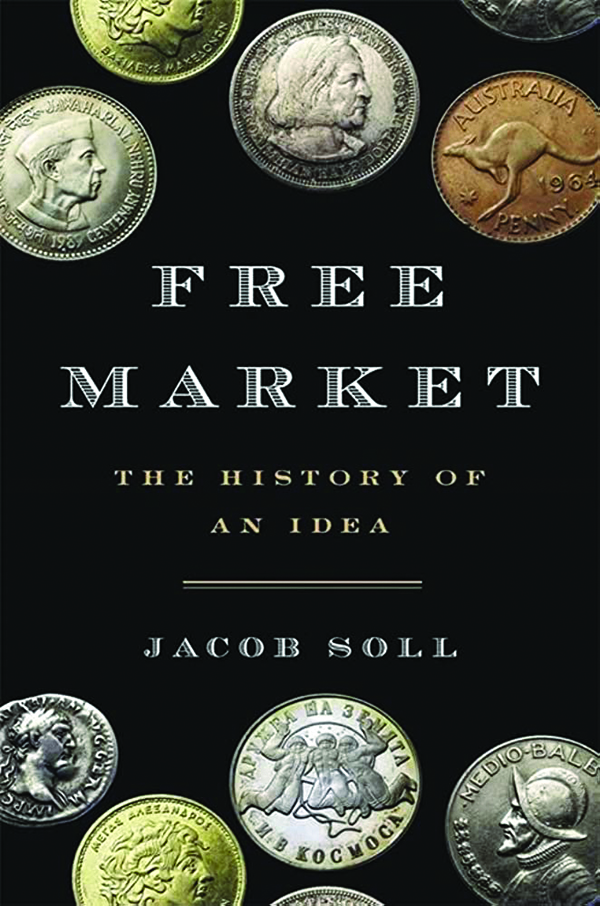
This little historian went to market
Varad Mehta
The historian of science Steven Shapin famously opened his 1996 study of The Scientific Revolution by declaring, “There was no such thing as the Scientific Revolution, and this is a book about it.” Jacob Soll doesn’t make a similarly bold venture into paradox at the beginning of Free Market: The History of an Idea by asserting that there’s no such thing as a free market, and this is a book about it. But the reader will likely reach that conclusion anyway, for its central theme is that a free market in the abstract, ideal sense has never existed and never can.

That hasn’t stopped the free market from becoming the dominant mode of economics around the globe, from the United States and its fellow liberal democracies to China. How the free market achieved this position of supremacy is the subject of Soll’s 2,000-year story.
Soll starts his narrative, therefore, not in one of the usual embarkation points such as 18th-century Britain or 17th-century Holland but in late Republican Rome. He does so because that’s where and when Cicero lived, and his ideas “would serve as the linchpin of economic thought for almost two thousand years.”
That great orator and philosopher established the two pillars upon which his successors erected free market doctrine: first, that agriculture, especially as directed by landed aristocrats, was the true source of wealth; and second, that morality was a necessary component of the market’s pursuit of economic equilibrium. Cicero thus anticipated “a central tenet” of Adam Smith’s thought: “If elite, educated men focused on agriculture and exchanged goods righteously and ethically, then the market would work on its own and produce wealth, and the republic would prosper.”
As an advocate for an agrarian economy overseen by a virtuous nobility is not how Smith is normally perceived. But Kirkcaldy’s most famous son was no “modern economic liberal, least of all a libertarian.” That false understanding is due to modern economists, who have “caricatured Smith and warped him into something he wasn’t.” Soll takes pains to erase the stereotyped portrait of Smith as a free market ideologue, depicting him instead as a philosopher keenly aware of the necessity of morality to the functioning of markets and skeptical of the interests of merchants.
To neutralize their monopolistic tendencies, a countervailing force was necessary. Smith found it in the state, which by thwarting their depredations and eliminating taxes on agriculture and land would allow the economy to flourish. So wedded was Smith to the traditional agrarian view that he couldn’t “understand that capital investment in technology and industry” is the only way to generate consistent growth.
Today the free market is indelibly associated with industrialization. But for most of history, its advocates, including Smith, saw agriculture as the only legitimate source of wealth and scorned trade and industry as irrelevant. Typical in this regard were the physiocrats, the 18th-century French economic thinkers whose outstanding figure was the physician Francois Quesnay. Physiocracy sought to restore the primacy of farming in the face of growing industry and commercialization. Yet Quesnay, despite his pioneering work on economic data and statistics, failed, as did Smith a few decades later, to perceive “that investment in industrial production brought infinitely more added value and returns than farm produce ever could.” Led by Quesnay, the physiocrats’ opposition to nonagricultural sectors became “fanatical” and the movement itself irredeemably “nostalgic.”
If physiocracy seems reactionary, that’s because it was. What it was reacting against was the legacy of Jean-Baptiste Colbert, the 17th-century French statesman who served as Louis XIV’s chief minister until his death in 1683. Colbert is known as the father of mercantilism, but Soll contends that term is a misnomer for his vision of protectionism, sovereign capital projects, and industrial policy. Modern free market thought arose in opposition to Colbert, but that was due, says Soll, to a false impression that he was to blame for the disasters that befell France during the catastrophic last thirty years of Louis XIV’s reign.
If there’s a hero to Soll’s story, it’s Colbert, who espoused robust government involvement “to foster the kind of innovation and industrial development” that would sustain “healthy interior markets while also allowing a nation to compete internationally.” Alexander Hamilton would successfully adapt this model for the newborn U.S., and it “still has resonance today in the dynamic authoritarian economies of Asia.” For most of history, Soll insists, “free market ideals coexisted with the more complex reality of state intervention.” A free market requires state intervention because only the state can free it. The notion that a perfectly free market can exist independently Soll rejects as utterly unrealistic.
Even though it’s less than 270 pages long, Soll’s study covers considerable territory, from late Republican Rome through the Christian triumph of the Middle Ages to the commercial republics of Renaissance Italy and the Anglo-Dutch and Anglo-French rivalries of the 17th and 18th centuries, then Britain’s 19th-century imperial dominion, finally completing his journey with the free market apostles of the 20th century.
Soll, a professor at the University of Southern California, is one of the country’s preeminent scholars of early modern Europe. Unsurprisingly, his footing is surest when he’s on this familiar ground. (One of his previous books was about Colbert.) In contrast, other chapters, like those on medieval Christianity, give the impression of a package tour: you hit the main attractions, but never get the inside knowledge you might if you stepped off the beaten path with someone who speaks the language like the locals do.
Nor does Soll’s concision always serve him well. A chapter on how 17th-century writers attempted to incorporate the era’s scientific discoveries into free market thinking is so short one suspects he wanted to utilize the material but couldn’t fit it anywhere else. Folded into another chapter, it might not feel so rudimentary. A discussion of the relationship between capitalism and the free market would have been helpful. Clearly they aren’t identical since on Soll’s telling, the one long predates the other. But what makes them distinct is a question he doesn’t address. And his discussion of free market ideology in post-World War II America, with its complaint that an idea once associated with radicals and revolutionaries was now being taken up by “archconservatives and neo-Confederate segregationist racists,” reads too much like a Twitterstorian screed against those nefarious Republicans, up to their usual tricks. All in all, some readers will appreciate the book for its scope and compactness, while others, because its brevity occasionally verges on the cursory, may leave dissatisfied.
There are, moreover, several shocking errors that make one wonder how they could get past a major publisher or, frankly, how a historian of Soll’s stature (he is a recipient of the MacArthur fellowship, the so-called genius grant) could make them.
He describes Queen Anne as William and Mary’s daughter (she was Mary’s sister), says Adam Smith’s father died when Smith was 7 months old (he died two months before Smith was born), and states that Prohibition passed when Herbert Hoover was president.
Whither the free market today? Its position seems unassailable. Yet Soll detects numerous cracks in the facade. The U.S. and its peers “are in an essentially abusive relationship with free market thought,” he posits. The model of a free, independent, self-sustaining market achieving equilibrium by itself “no longer seems realistic or relevant.” The only way to make the doctrine viable for the 21st century, he proposes, is to accept “that the state is embedded in the market and vice versa.” How their connection will change in the future, no one knows. All we can be sure of is that change it will and, with it, our conception of the free market, too.
Varad Mehta is a writer and historian. He lives in the Philadelphia area. Find him on Twitter @varadmehta.
